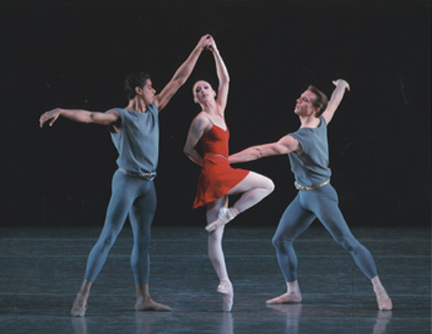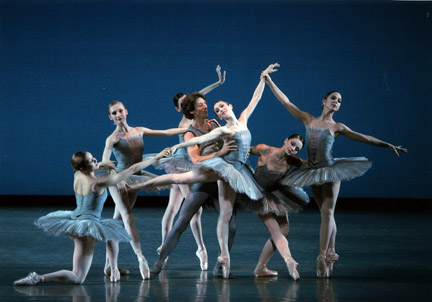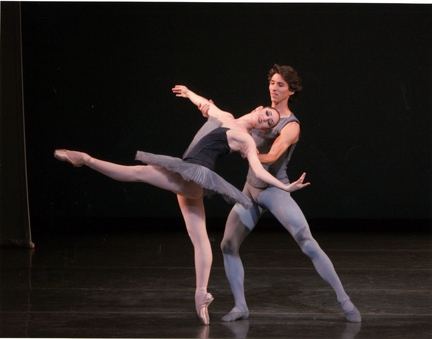Choreographers in the house
“The Red Violin," "Herman Schmerman pas de deux," "Evenfall"
New York City Ballet
New York State Theater
New York, NY
May 10, 2006
by Leigh Witchel
copyright ©2006, Leigh Witchel

The Spring Gala for NYCB was mostly home-grown this year. It included
Diamond Project premieres from two in-house choreographers as well as a
shorter and older work from William Forsythe. Christopher Wheeldon, the
company's resident choreographer, closed the evening with a new ballet that
showed why people have faith in his potential and talent.
Peter Martins’ new work began the evening. “The Red Violin” was danced to a score of the same name composed by John Corigliano. Like the one by Petris Vasks that Martins used for “Tala Gaisma,” it’s atmospheric but not designed for dance. The ballet is a plotless work for four couples; Jennie Somogyi with Sébastien Marcovici and Amar Ramasar with Sara Mearns got top billing; Sean Suozzi with Tiler Peck and Andrew Veyette with Sterling Hyltin did only slightly less and occasionally function as a corps de ballet. The men were in identical simple blue gray outfits; the women each wore a different bright color. The work recalls the larger “Fearful Symmetries;” both share Martins’ skidding, punchy vocabulary.
“The Red Violin” is a competent if familiar looking work but shares the opacity that is often perplexing in Martins’ work. Besides casting exigencies, what’s going on? It feels as if Martins has cast the work, as he has done before, to show us either new or underused faces. Somogyi is in the midst of a successful comeback; it makes sense to set a ballet on her to help that along. Most of the other dancers are from the crop of newly promoted soloists with the exception of Peck and Suozzi, but it’s a good guess Martins has his eye on both of them as well. The work does have a palpably emotional atmosphere; the same ambivalent one Martin has mined in most of his darker works. But as with most of those other works, one still feels at arm’s length from the ballet and whatever its intentions may be. As usual Kurt Nikkanen does a fine job as the violin soloist.
“Herman Schmerman” has an unusual history. It had its premiere in the first Diamond Project in 1992, but as a quintet. A year later, a pas de deux was added for Wendy Whelan and guest artist Kevin O’Day. When the piece was revived several years later, only the appended pas de deux was shown; the quintet (which featured Jeffrey Edwards, who outdid himself in Forsythe) was dropped.
 Others have danced it elsewhere, but Whelan has owned her role in the pas de deux since it was made on her, though she now performs it with Albert Evans. They gave a broad, muggy interpretation of the dance, but galas aren’t subtle affairs. The dance is an example of choreography as dialogue: one dancer moves; the other moves in response. The vocabulary is loose and quirky, half ballet and half seemingly improvised. The work also has a punchline: Whelan left the stage to return, having donned a bright yellow pleated skirt. Evans left in response and returned bare-chested, also wearing a yellow skirt. But right after they launched into a duet filled with kinetic enchaînements that brought back the days of Forsythe at his best when he was making dances that danced.
Others have danced it elsewhere, but Whelan has owned her role in the pas de deux since it was made on her, though she now performs it with Albert Evans. They gave a broad, muggy interpretation of the dance, but galas aren’t subtle affairs. The dance is an example of choreography as dialogue: one dancer moves; the other moves in response. The vocabulary is loose and quirky, half ballet and half seemingly improvised. The work also has a punchline: Whelan left the stage to return, having donned a bright yellow pleated skirt. Evans left in response and returned bare-chested, also wearing a yellow skirt. But right after they launched into a duet filled with kinetic enchaînements that brought back the days of Forsythe at his best when he was making dances that danced.
Wheeldon’s new ballet, “Evenfall,” closed the program. As interesting as the music is, one wouldn’t suspect that Bartók’s third piano concerto would be danceable, but Wheeldon has a knack for unknotting thorny scores. Like Martins, he’s accommodating the company’s needs; durable large-cast ballets are constantly in demand at NYCB, especially to close the program. This work is also plotless, but where Martins presented an atmosphere and Forsythe a relationship, Wheeldon tapped into ballet’s myths through its forms.
The dancers, clad in gray with the women in classical tutus, danced on a stage expertly lit by Mark Stanley to conjure the shifting moods of light sliding into darkness. Wheeldon’s particular gift is his choreography for the corps de ballet. This ballet has a large corps; twelve women and six men. Wheeldon has a sure sense of geometry, patterning and vocabulary. He’s always searching for new ways to move the corps and if sometimes the invention seemed precious, it may not in two or three years.
 Damian Woetzel danced with Miranda Weese, but was often blocked from her by the corps. Wheeldon set the corps bobbing on their pointes in front of Woetzel as Weese receded from him, recalling “Swan Lake”. Another convention Wheeldon latched on to was the classical tutu, but instead of a comforting point of reference, he’s using it for a completely different purpose. The stiff classical tutu skirt has no modern cognate; women don’t presently wear anything like it. But he’s not using it as an article of clothing, rather as a sculptural shape. The corps often bent over to display the circular form of the skirt like outspread parasols. The dancers were occasionally in unwieldy positions, but somehow it worked. The tutus were so integral to the visual concept of the piece that he couldn’t have used any other costume.
Damian Woetzel danced with Miranda Weese, but was often blocked from her by the corps. Wheeldon set the corps bobbing on their pointes in front of Woetzel as Weese receded from him, recalling “Swan Lake”. Another convention Wheeldon latched on to was the classical tutu, but instead of a comforting point of reference, he’s using it for a completely different purpose. The stiff classical tutu skirt has no modern cognate; women don’t presently wear anything like it. But he’s not using it as an article of clothing, rather as a sculptural shape. The corps often bent over to display the circular form of the skirt like outspread parasols. The dancers were occasionally in unwieldy positions, but somehow it worked. The tutus were so integral to the visual concept of the piece that he couldn’t have used any other costume.
It was also nostalgic to see Weese and Woetzel together. As with “Herman Schmerman”, it feels like old times, recalling a decade ago when they were often paired because she was the only match for him in virtuoso dances. Ah, good times. There’s a lot to see in the ballet, more than one can catch in a single viewing. But in “Evenfall”, Wheeldon is doing just what one would hope he’d do with his talent and resources. He’s making classical ballets for our era.
Photos, all by Paul Kolnik:
First: Amar Ramasar, Jennie Somogyi annd Sebastien Marcovici in Peter Martins' new "The Red Violin."
Second: Rachel Piskin and Damian Woetzel, and ensemble, in Christopher Wheeldon's new "Evenfall."
Third: Miranda Weese and Damian Woetzel in "Evenfall."
Volume 4, No. 19
May 15, 2006
copyright ©2006 Leigh Witchel
www.danceviewtimes.com